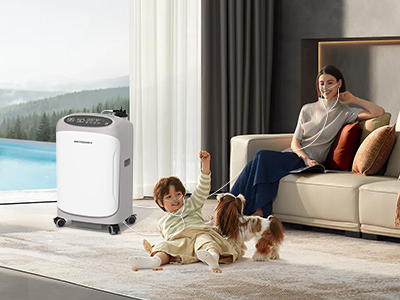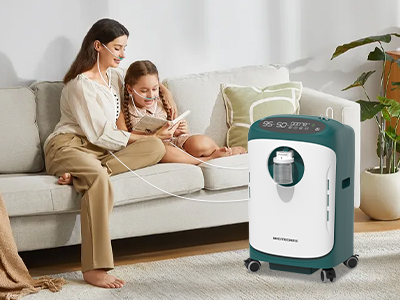25 Jul 2025
When breathing becomes a battlefield, oxygen therapysteps in like the calm, collected superhero no one invited—but everyone’s grateful for. For children grappling with asthma or COPD (yes, children can have it too), breathing isn't just a background process. It's a daily challenge, sometimes accompanied by wheezing, coughing, and a lot of parental pacing.
Oxygen therapy can transform that struggle into something far more manageable—think of it as giving your child’s lungs a pair of cozy slippers and a smooth escalator instead of a rocky hill. But what does it look like in real life? Let’s break it down.

Understanding Asthma and COPD in Children
Asthma is the drama queen of chronic respiratory illnesses. One minute your child’s running through the sprinklers, and the next, they’re gasping like a fish out of water. It’s unpredictable, it’s inflammatory, and it loves to overreact to things like dust, pollen, or the audacity of cold air.
COPD, on the other hand, is the grizzled old cowboy of lung conditions—slow, chronic, and misunderstood. While it's less common in children, some kids with long-term exposure to irritants or who have genetic conditions like alpha-1 antitrypsin deficiency can develop COPD-like symptoms.
Both conditions narrow the airways and interfere with gas exchange, which means less oxygen is reaching the bloodstream. Less oxygen = tired bodies, foggy brains, and cranky little humans.
How Oxygen Therapy Helps
Picture oxygen therapy as the VIP express lane at the airport—no waiting, no struggling, just fast, efficient delivery of what your kiddo needs most.
The Benefits:
Improved energy – fewer midday crashes and more time for glitter explosions and Legos.
Better sleep – no more overnight coughing symphonies or waking up feeling like they’ve just run a marathon.
Brain boost – oxygen helps keep attention sharp, moods even, and tantrums... well, at least not oxygen-related.
Heart support – less strain on the heart means better long-term outcomes.
Oxygen doesn’t cure asthma or COPD, but it sure knows how to be an excellent wingman.
When Do Kids Need Oxygen Therapy?
Spoiler alert: it’s not every wheeze and sneeze. Oxygen is prescribed based on hard science—specifically blood oxygen levels. When SpO₂ drops below 90%, that’s the red flag waving in the respiratory wind.
Common Situations:
During acute flare-ups – asthma attacks or COPD exacerbations can cause sudden drops in oxygen levels.
At night – when shallow breathing can go undetected until morning grumpiness hits.
During colds or infections – even a little snot can wreak major havoc on delicate lungs.
While active – if playtime leaves your child gasping, supplemental oxygen can help them enjoy being a kid again.
Doctors typically order pulse oximetry or arterial blood gas tests to determine whether oxygen is needed—and how much.
Types of Oxygen Delivery for Kids
Oxygen therapy isn’t a one-size-fits-all solution. Kids come in all shapes, sizes, and attitudes, so naturally, oxygen delivery has options too.
Nasal Cannula
The MVP. Two small prongs fit into the nostrils, delivering oxygen discreetly. Comfortable enough to wear while watching cartoons or refusing vegetables.
Face Mask
Used for higher oxygen flow or for children who are allergic to subtlety. Covers the nose and mouth—sometimes decorated with dinosaurs or ladybugs for maximum compliance.
Oxygen Hood or Tent
Perfect for infants who haven’t learned how to keep things on their face. It’s like a little oxygen spa retreat—minus the cucumber water.
Portable Concentrators
For families on the go. Smaller, battery-powered units that allow kids to visit grandma, go to school, or star in the grocery store’s next aisle meltdown—all while staying oxygenated.
Creating a Kid-Friendly Oxygen Setup at Home
A sterile hospital vibe may work for doctors, but children need something a little less... beige.
Pro Tips for a Pediatric Oxygen Wonderland:
Color-coded tubing (because neon green makes everything cooler).
Stickers and personalization on machines help reduce fear and build ownership.
Tidy cord management to prevent tripping, tugging, or booby-trap scenarios.
Keep emergency backups—power outages and toddlers both have terrible timing.
Also, designate a “breathe-easy” zone at home—a cozy corner or beanbag throne where oxygen therapy can happen without drama.
Safety First: Managing Oxygen Around Curious Kids
Children and high-concentration oxygen are a spicy combination. Curiosity is lovely, but not around flammable gases.
Essential Rules:
No flames, ever. That includes candles, lighters, and your aunt’s incense collection.
Avoid petroleum-based balms near the nose (switch to water-based if needed).
Store tanks upright and in cool, ventilated spaces.
Supervise usage—toddlers are known for unplugging things just to watch the lights blink.
Oxygen therapy can be perfectly safe—as long as grownups outsmart the tiny chaos agents.

Working with Schools and Caregivers
Children don’t live in a vacuum (unless that vacuum is under the couch with snack crumbs). They go to school, visit friends, and get babysat. Making sure their oxygen needs are met wherever they are is crucial.
What to Do:
Develop an Oxygen Care Plan – include when, how, and how much.
Train caregivers – yes, even Grandma.
Label everything – machines, cords, carrying cases.
Communicate openly with teachers and school nurses—they’re part of the team too.
Empowered caregivers = fewer emergencies and more peace of mind.
Helping Kids Emotionally Adjust
Let’s be real: wearing oxygen equipment can feel awkward, especially in a world of curious classmates and uninhibited toddlers.
Support Strategies:
Books and videos featuring kids with similar gear help normalize the experience.
Role-playing with stuffed animals can turn fear into fun.
Peer support groups or child therapy can be game-changers for older kids.
Celebrate milestones—every successful oxygen session deserves high-fives, stickers, or interpretive dance.
Confidence grows when children feel seen, supported, and a little bit like oxygen-wielding superheroes.
Keywords: oxygen therapy
Originally published 25 Jul 2025, updated 25 Jul 2025.